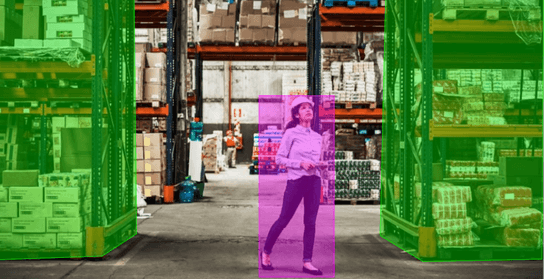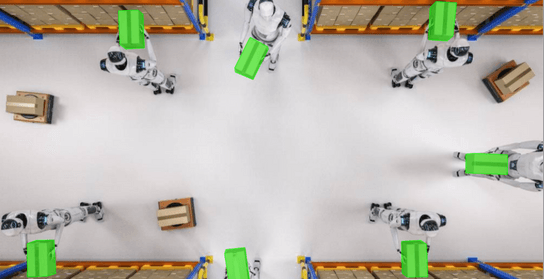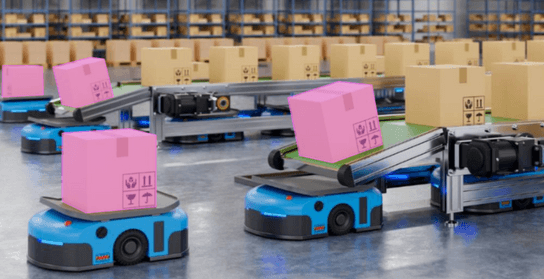How to leverage AI and Data Annotation for Warehouse management
A scalable business depends heavily on the kind of systems you have implemented. Businesses that still rely on manual entry of inventory items in spreadsheet documents cannot have an accurate measure of the product they have on hand. So, what’s the solution? It’s quite simple actually, your data needs to harness the power of Artificial Intelligence (AI), Machine Learning (ML), and data science.
A smart warehouse combines various interconnected technologies to form an ecosystem whereby an entire business operation, from supply to delivery, is governed by AI. Goods are received at the warehouse, identified and sorted, processed, packaged, and pulled for shipment, all automatically and with minimal margin for error. Warehouse management will become more agile, with faster responses to logistical demands of material items and personnel, and more scalable in terms of finding new solutions for greater volume and flow of product.
Application of AI in Warehouse
Fully automated warehousing has not yet been achieved, but these are some of the ways AI will transform warehouse management:
Inventory tracking and management
Computer vision and AI can be used to track the inventory within the warehouse. Cameras can be installed at various points in the warehouse to monitor the location of goods. AI algorithms can then be used to analyze the video footage and identify the location of each item, making it easy to track and manage inventory levels. RFID (radio frequency identification) replaces paper trails and barcode scanners for the organization and control of inventory, tracking products with digital tags and enabling a more precise and accurate inventory control.

Defect and Anomaly Detection
In terms of inspection, computer vision is a game-changer for logistics companies. Instead of verifying each parcel manually, they can let the machines do the job and focus on more demanding, higher-value tasks. Trained with depictions of flawless products, the AI models quickly detect any defect or anomaly. Based on the output, the computer vision-powered system makes an autonomous decision to redirect the item for manual inspection. Such a solution offloads the employees while helping the company maintain the highest customer satisfaction rates.
Order picking
Computer vision and AI can be used to streamline the order-picking process. Cameras can be installed to capture images of the products, which can then be analyzed by AI algorithms to identify the items that need to be picked for each order. This can help to reduce the time it takes to fulfill orders and improve the accuracy of the picking process. Some machines can now even pack the products themselves, using AI to optimize the space and materials.

Autonomous Robots
AI is already transforming warehouses with the use of robots, which can pick up goods and redistribute them within a fraction of the time required by human operatives. Computer vision can be used to enable autonomous vehicles to move around the warehouse. Cameras and sensors can be used to help vehicles navigate around obstacles and find the most efficient route to their destination. This can help to reduce the time it takes to move goods around the warehouse and improve the overall efficiency of the operation.

Predictive maintenance
AI can be used to analyze data from sensors and cameras within the warehouse to predict when equipment is likely to fail. This can help to prevent downtime and reduce the costs associated with maintenance and repair. machine-learning algorithms enable detailed stock movement forecasting and management to fine-tune material handling. In this way, operator error and processing times can be reduced, with corresponding increases in overall efficiency and productivity.
Data Annotation for AI-based Warehouse Management
Warehouse and inventory management are critical components of supply chain management that involve the systematic storage and tracking of goods and products. AI-based solutions can significantly improve the efficiency and accuracy of warehouse and inventory management, leading to better customer service, reduced costs, and increased profits.
To train an AI-based model for warehouse and inventory management, data is collected from various sources, including historical inventory data, sales data, and shipping data. The data is then preprocessed, cleaned, and organized to remove any inconsistencies, errors, or duplicates. This is where our data annotation services come in, as they can help in ensuring the accuracy and completeness of the data.
Once the data is preprocessed and cleaned, it is split into training, validation, and testing sets. The training set is used to train the AI-based model, while the validation and testing sets are used to evaluate the performance of the model.
The AI-based model is then developed using a combination of supervised and unsupervised learning techniques. For supervised learning, annotated data is used, which is labeled with the correct output. Our data annotation services can provide the required labeled data for the supervised learning process. For unsupervised learning, the model is trained on unlabeled data, and the algorithm learns to recognize patterns and relationships in the data.
After the model is trained, it is tested to ensure it performs accurately and consistently. The model is then deployed into the warehouse and inventory management system, where it can be used to optimize inventory levels, reduce out-of-stock situations, improve delivery times, and minimize excess inventory.
TagX can play a critical role in preparing the data required to train AI-based models for warehouse and inventory management. With accurate and complete data, AI-based models can significantly improve the efficiency and effectiveness of warehouse and inventory management, leading to better business outcomes.
Benefits of AI in Warehouse
AI is, without a doubt, a revolutionary technology. If AI is not currently used in your warehouse, it may be time to start. Here are some immediate and long-term ways artificial intelligence can enhance your business operations:
Improved Productivity
Although there will always be a need for human labor, there are some tasks that warehouse automation robots can perform more quickly and accurately. AI-powered systems can optimize tasks and streamline operations, leading to improved efficiency and faster turnaround times. For example, automated picking systems can increase picking speed and accuracy, reducing the time and labor required for manual processes.
Safer Workplace
AI tools can continuously monitor the environment and activities in a warehouse. They can evaluate activities and assign them a risk score. High-risk tasks can be delegated to robots, leaving humans to handle safer duties. For instance, autonomous mobile robots can navigate through the warehouse floor and avoid obstacles, reducing the need for human intervention and minimizing the risk of collisions.
Cost Savings
Adopting AI solutions can reduce costs for your company by fostering efficiencies and reducing warehouse overhead. These systems can help warehouses reduce costs by optimizing workflows and minimizing waste. For example, machine learning algorithms can predict demand patterns and optimize inventory levels, reducing the cost of holding excess inventory.
Simpler Inventory Management
AI can assist your warehouse in determining market conditions, allowing you to manage your inventory better. AI solutions can simplify inventory management by providing real-time visibility into inventory levels, locations, and movements. This helps warehouse managers optimize inventory levels and reduce stock-outs, while also minimizing the risk of overstocking.
Enhanced Customer Experience
AI-powered warehouses can improve the overall customer experience by enabling faster delivery times and more accurate order fulfillment. This helps businesses differentiate themselves from competitors and improve customer satisfaction. Companies can better understand their current situation, spot patterns, and develop strategic plans with the algorithmic analysis provided by AI.
The Key Takeaway
Using automated inventory management can aid in both physical tasks such as the relocating and tracking of items to more complex tasks where data and advanced insights are required for error-free planning and demand forecasts. It saves on costs, and manpower, and can bring added security by monitoring systems to notify you of any potential ransomware or cyber-attacks.
As businesses grow, AI-powered methods will become necessary to improve inventory and secure long-term growth. Along with a powerful cloud to secure your data and spin up workloads quickly, using AI will be essential to the success of your business. Get ahead of the game now by deploying artificial intelligence inventory management today with TagX.